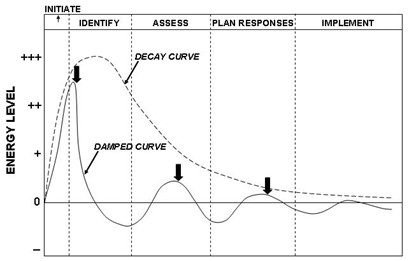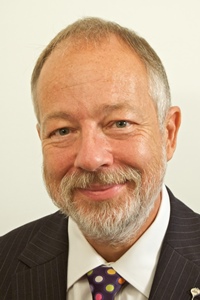Developing Renewable and
Sustainable Risk Management
SECOND EDITION
Dr David Hillson PMI Fellow, HonFAPM
aka The Risk Doctor
Petersfield, UK
Abstract
Risk management needs constant attention if it is to be fully effective. But many project teams find it hard to maintain the energy levels required by the risk process. This paper introduces the concept of “risk energetics” to explore the reasons for poor risk management performance. It is natural for energy levels to decay with time, and this will affect how the risk process is implemented if there is no active intervention. Risk energetics explains how the natural decay curve can be exacerbated by negative influences, and indicates how to maintain energy levels throughout the risk process with key re-energising factors. It also suggests how to develop renewable and self-sustaining energy from one project to the next to promote risk maturity in the organisation.
Introducing “Risk Energetics”
It is self-evident that projects are risky and that risk should be managed proactively in order to optimise project performance. While it is undoubtedly true that risk management is not complex, there are a number of challenges which those wanting to manage risk in their projects need to address and overcome. Risk management is an essential component of how projects should be managed, but anyone who takes a casual approach to managing project risk is likely to encounter difficulties. One significant barrier to effective risk management is the loss of energy during execution of the risk process, leading to lack of commitment and action by the project team and other stakeholders. Fortunately energy levels throughout the risk process can be actively managed, using the new approach of “risk energetics” (Hillson 2009), which is described in this paper.
The natural decay curve
The starting point for risk energetics is the natural decay curve which is experienced by an energy pulse in a free and unconstrained setting, as illustrated by the dashed line in Exhibit 1. A rise in energy follows the initial input, but this quickly starts to decline and ultimately reaches zero.

Exhibit 1: Risk energetics – Natural Decay and Damped curves
This decay curve can also be used to illustrate the level of energy that is evident in a group of people who are seeking to manage risk (for example a project team), if their situation is unmanaged and without external input. Following a period of initial enthusiasm, their degree of engagement soon peaks and starts to reduce, until they eventually lose interest in the risk management process. This may be due to natural busy-ness and tiredness resulting from the day-to-day work of performing the project, or it may arise from other distractions that prevent the team from applying themselves to the risk process.
The damped curve
However, some project teams experience active discouragement and barriers to managing risk on their project. This can lead to a damped curve as shown by the solid line in Exhibit 1, with the black arrows indicating the damping points. The result is zero or negative energy and failure to engage with the risk process.
The typical risk management process includes a number of standard steps. Different risk standards and guidelines use different names for the various process steps (Association for Project Management, 2004; Hillson & Simon, 2020; Project Management Institute, 2017, 2019; International Organization for Standardization, 2018), but a typical risk management process includes the following main stages (among other steps):
More…
To read entire article, click here
Editor’s note: Second Editions are previously published papers that have continued relevance in today’s project management world, or which were originally published in conference proceedings or in a language other than English. Original publication acknowledged; authors retain copyright. This paper was originally published in Proceedings of the 2011 PMI Global Congress in Dublin, Ireland. It is republished here with the author’s permission.
How to cite this paper: Hillson, D. (2023). Risk Energetics: Developing Renewable and Sustainable Risk Management; original version published in the Proceedings of the 2011 PMI Global Congress, Dublin, Ireland; republished in the PM World Journal, Vol. XII, Issue I, January. Available online at https://pmworldlibrary.net/wp-content/uploads/2022/12/pmwj125-Jan2023-Hillson-Risk-Energetics-developing-renewable-and-sustainable-risk-management-2nd-ed.pdf
About the Author

Dr David Hillson, HonFAPM, PMI-Fellow, CFIRM
The Risk Doctor
![]()
Known globally as The Risk Doctor, Dr David Hillson is a thought-leader and expert practitioner who speaks and writes widely on risk management. David has a well-deserved reputation as an excellent speaker and presenter on risk. His talks blend thought-leadership with practical application, presented in an accessible style that combines clarity with humour, guided by the Risk Doctor motto: “Understand profoundly so you can explain simply”.
David has advised major organisations, governments and charities in nearly sixty countries on how to create value from risk using applied risk-based thinking, and his wisdom and insights are in high demand. David has written 14 major books on risk, and he has developed significant innovations that are now widely accepted as best practice. He regularly shares his work through the RiskDoctorVideo YouTube channel, with over 200 videos and more than 1.5 million views.
Dr Hillson has received many awards for his ground-breaking work in risk management. He is a Fellow of the Project Management Institute (PMI) and also an Honorary Fellow of the UK Association for Project Management (APM), as well as a Chartered Fellow of the Institute of Risk Management (IRM).
To view other works by David Hillson that have been published in the PMWJ, visit his author showcase in the PM World Library at https://pmworldlibrary.net/authors/dr-david-hillson/









